Chinese Seal Identification Guide for Calligraphy and Painting
Many people interested in Chinese calligraphy and painting art may notice that most Chinese calligraphy or painting works have seals on them. Chinese seal identification can be very difficult for foreign friends who are new to Chinese art or those who rarely encounter Chinese seal carving, yet it’s also full of fascinating charm that draws people to explore.
These hard-to-recognize seals can be viewed as the artist’s “signature,” the connoisseur’s “fingerprint,” and even more so as “miniature codes” that carry the essence of history, culture, and art.
In today’s article, Qi Ming will provide readers interested in Chinese calligraphy and painting seals with a rigorous and practical identification guide. From basic seal knowledge to core methods of seal identification, we’ll help you gradually unlock the mysteries within these small squares.
Basic Knowledge of Seals
To identify seals, you must first understand their basic structure and classification.
In Chinese culture, seals are far more than simple marks – they are an art form called “seal carving.” The origin of seal carving art can be traced back to the late Shang Dynasty (over 3,000 years ago). The bronze seals excavated from the Anyang Yin Ruins serve as the earliest physical evidence, marking the formation of the early combination of practical use and artistic value.
What is a Seal?
From a physical perspective, a seal is a carved piece of stone, wood, or metal. When it’s dipped in vermillion ink paste and pressed onto rice paper, it leaves an imprint. These imprints are what we call “seals.”
Common seal stone materials include Shoushan Stone, Qingtian Stone, and Changhua Stone. Qi Ming previously explained these in detail in the article “Best Stone Materials for Chinese Seal Carving: A Complete Guide.” Additionally, there are materials like jade, wood, and copper.
Also, if you want the text on the seal to appear on paper, you must use ink paste. This means the seal must first be dipped in ink paste before it can be stamped on calligraphy and painting works. High-quality ink paste mainly consists of cinnabar, supplemented with mugwort floss, castor oil, and other ingredients. I will write a dedicated article about ink paste in detail later.
Classification of Seals
Seals come in many varieties, and their functions and uses determine their different roles in artworks. We can classify them into the following categories based on their content and purpose:
Name Seal: The most common type of seal, used to indicate the identity of the author or collector. It usually bears the author’s full name, courtesy name, or alias. For example, the famous calligrapher named “Qi Gong” might have a name seal carved with “Qi Gong” or “Yuan Bai.”
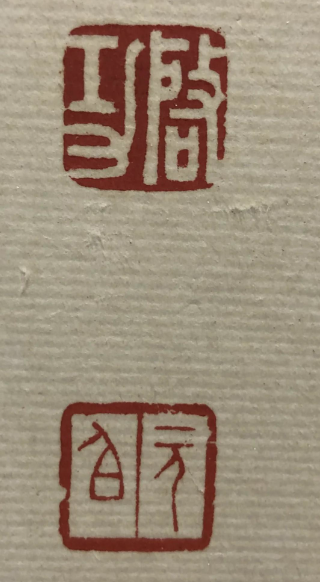
This is the name seal of the famous Chinese calligrapher Mr. Qi Gong.The text in the seal above reads “Qi Gong.” The seal text below reads “Yuan Bai.” Qi Gong is the name, while Yuan Bai is Mr. Qi Gong’s courtesy name.
Leisure Seal: These seals have the richest content, carved with poetry, mottos, moods, or auspicious phrases. Artists often use leisure seals to express their state of mind during creation, aspirations, or insights about life. For example, a leisure seal carved with “undisturbed by favor or disgrace” expresses a mindset above worldly concerns, while “harmony between heaven and humanity” reflects philosophical thinking.
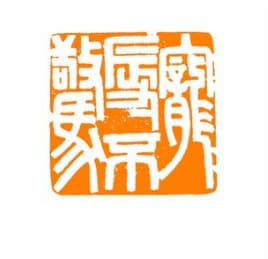
This is a typical leisure seal (the text above reads: undisturbed by favor or disgrace 宠辱不惊).
Collection Seal: Seals stamped by collectors or connoisseurs on treasured calligraphy and painting works. These seals serve as strong evidence of the work’s clear provenance. For example, Emperor Qianlong of the Qing Dynasty had many collection seals, which appear on many famous paintings passed down through history, recording that these works were once collected by the imperial family.
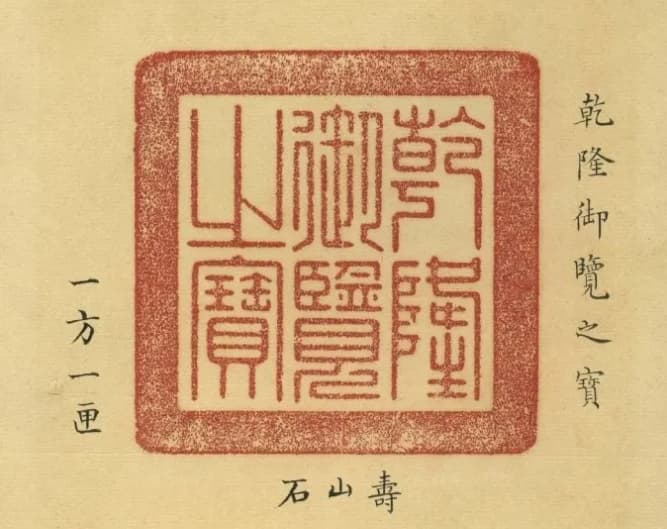
Emperor Qianlong’s collection seal.(Qianlong Imperial Review Treasure 乾隆御览之宝)
Position of Seals in Artworks
The position of seals is not random – it’s closely related to the composition and inscription of the work.
Author seals are usually stamped at the end of the inscription, forming a harmony with the signature text, bringing balance and harmony to the work.
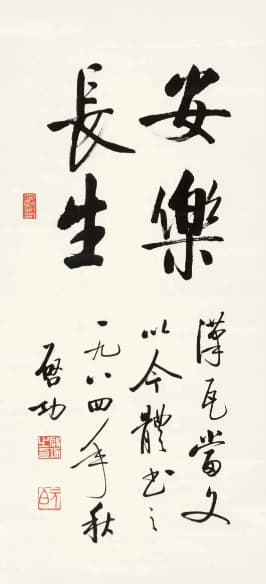
Mr. Qi Gong’s calligraphy work – you can see that the position of the seals on the work is very carefully considered.
Collector seals are relatively more flexible, usually stamped in blank areas of the painting, following the principle of not affecting the beauty of the work itself.
However, this isn’t always the case. For example, Emperor Qianlong’s collection seals were relatively casual. He can be said to be the person in Chinese history who most loved stamping seals on ancient calligraphy masterpieces. He’s called the “seal-stamping maniac” by many people online. Wang Xianzhi’s “Mid-Autumn Post” has only about 30 characters, but Emperor Qianlong stamped over 80 seals on it.
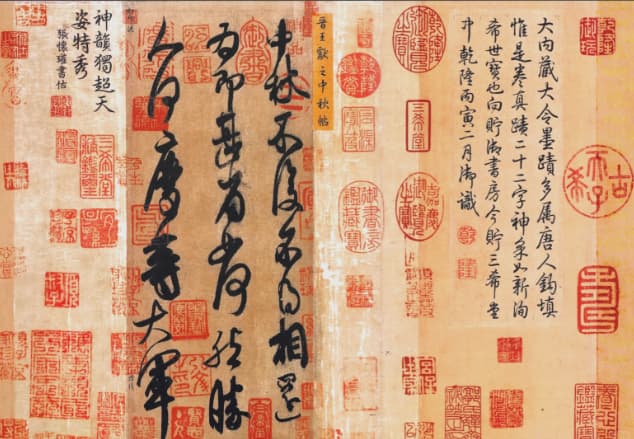
This is Wang Xianzhi’s Mid-Autumn Post – many of the seals on it come from Qianlong.
Core Methods for Identifying Seals
Identifying seals is like a detective solving case clues – it requires systematic methods and keen observation. The key challenge is that seals almost always use an ancient script called seal script.
Seal Script
Seal Script is one of the oldest Chinese character fonts. If you visit some historical and cultural sites in China, you’ll usually see some inscriptions carved on stone tablets. The tops of these inscriptions are generally written in seal script, representing formality and solemnity.
Its strokes are rounded and the structure is balanced, very different from the regular script or running script we use today. Almost all seals use seal script, making seal identification extremely difficult. Even modern Chinese people may need to learn some knowledge or use tools and professional help to identify the text content on a particular seal.
Characteristics of seal script: Strokes are mostly curved and straight lines, emphasizing symmetry. The overall structure presents an ancient, dignified quality. Different seal script styles, such as the small seal script of the Qin Dynasty and the Han seal script of the Han Dynasty, have different stroke thickness and structural density.
How to Recognize Seal Script?
(1) Contextual Association Method
This is the most direct and effective method. Usually, artists write inscriptions in regular script or running script next to the seal, which include the artist’s name or creative content.
First, read the inscription text and find the artist’s name, for example “Qi Gong.”
Next, observe the seal next to the inscription and try to compare the seal script characters in the seal with the regular script characters of “Qi Gong.”
The logic behind this is that after artists complete their inscriptions, the content of the seals they stamp usually corresponds with the names, courtesy names, or studio names in the inscription. Through this method, even without knowing seal script, you can roughly deduce the content of the seal.
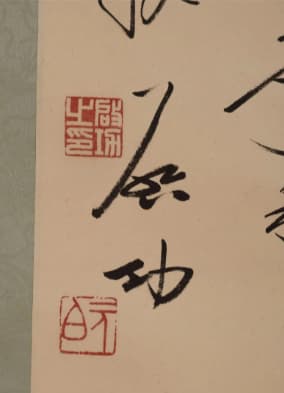
By finding the author’s name, you can also deduce the general content of the seal. This is a very effective method, especially for identifying name seals.
(2) Character Form Comparison Method
When contextual information is limited, we need to use tools to identify seal script. For many friends who want to identify Chinese calligraphy and painting seals, using tools to identify seals may be the most direct approach.
Using online seal identification tools: There are many specialized seal script dictionaries on the internet (for example, some websites or applications that provide “Chinese seal script dictionary” services). You can input the character forms from the seal through copying or image recognition into these tools, and they will match the corresponding modern Chinese characters for you.
Radical decomposition method: Although the structure of seal script is ancient, many characters’ radicals can still be traced. Try to break down a complex seal script character into several parts – this helps narrow the search range and improve identification efficiency.
(3) Identifying Seal Content Through Side Inscriptions
Side Inscription refers to text carved on the sides of seals. Usually written in regular script or running script, it records information about the seal’s carver, carving time, location, and recipient. These characters have clear strokes and are easy to recognize, serving as important supporting evidence for authenticating seals and determining their origin. On some ancient seals, side inscriptions may even have more research value than the seal text itself.
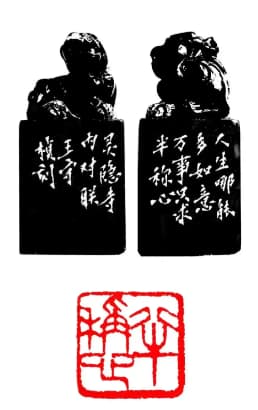
This is a typical seal with a side inscription, and the side inscription also mentions the three characters carved on the seal: “Half Satisfied.”
Understanding History and Value of Artworks Through Seals
The ultimate purpose of identifying seals is not just to read the text on them, but to use this information to gain deeper understanding of the artwork’s value and story.
Authenticating Authors and Authenticity
An artist’s personal seals are an important part of authenticating artwork. Famous artists’ seals have distinctive personal characteristics in their carving style, knife technique, and layout, just like their painting style or handwriting, making them difficult to imitate.
For example, Qi Baishi’s seals have mature knife work and powerful momentum, while Wu Changshuo’s seals are ancient and vigorous, full of bronze and stone spirit. These unique styles provide us with important authentication criteria.
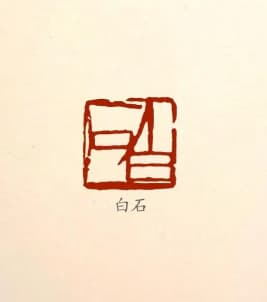
This is Qi Baishi’s seal (seal text: Bai Shi).
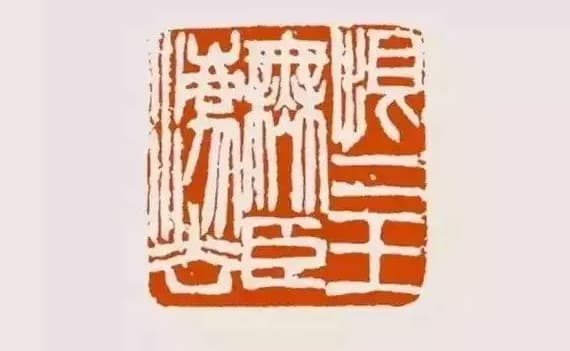
This is Wu Changshuo’s seal (seal text: Hate that the Two Wangs Have No Minister’s Method).
I believe everyone can feel the different styles of these two artists through their seal carving works. In Qi Ming’s view, Qi Baishi’s seals appear more lean and strong, while Wu Changshuo’s seals are relatively more robust.
Tracing the Historical Transmission of Artworks
A famous painting passed down through history often bears multiple collection seals from different periods. These collection seals are like historical “tickets,” recording which famous collectors treasured the work in different periods.
By interpreting these seals, we can piece together the complete provenance of the artwork, greatly enhancing its historical and artistic value. For example, the calligraphy work by Wang Xianzhi we saw earlier actually also has collection seals from dignitaries and nobles throughout various dynasties.
Understanding Historical Background and Artistic Thought
The carving style, font choice, and leisure seal content of seals all deeply reflect the cultural background and artistic trends of their era. For example, the seals of late Qing seal carvers like Zhao Zhiqian and Wu Changshuo broke through the constraints of traditional literati seal carving, incorporating bronze and stone spirit and calligraphy-painting meaning into seals, creating new seal carving schools.
By studying these seals, we can glimpse the development of Chinese seal carving art.
Conclusion
Overall, seals on Chinese calligraphy and paintings are miniature landscapes of history, soul monologues of artists, and spiritual journeys of collectors. Identifying them is not just character recognition, but also cultural exploration and tracing origins.
Now you have mastered the key to unlocking these “miniature codes.” When you next face a Chinese calligraphy and painting work, why not focus your attention on those red seals?
Start with the nearby inscription, use online seal identification tools, observe the character forms in the seal text, and look for clues in side inscriptions to identify the textual content of the seals. You’ll discover that these small seals are far more charming than you imagined – they will lead you into a broader, richer world of Chinese art.


